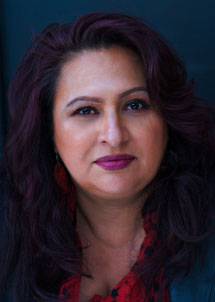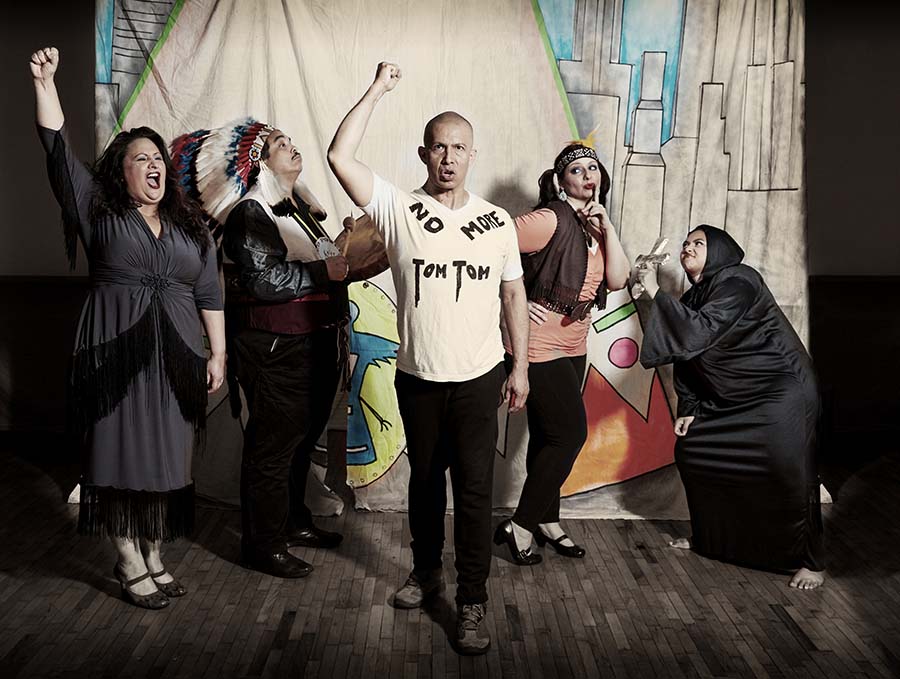Murielle Borst Tarrant describes herself as an urban Indian. Raised in the Red Hook section of Brooklyn, she is one of more than 100,000 members of various Native nations who reside in New York City (hers: Kuna/Rappahanock nations). She’s also, not coincidentally, a five-decade veteran of the entertainment industry, a family business that saw her ancestors performing in Wild West shows, including pageants, sideshows, and other popular entertainment known as Americana.

She draws on that history in Don’t Feed the Indians—A Divine Comedy Pageant!, in its world premiere Nov. 2-19 at La MaMa ETC. The play, which received a 2017 New England Foundation for the Arts (NEFA) National Theater Project Creation & Touring Grant, features a cast six, including her husband Kevin Tarrant (Hopi/Hochunk nations), who also serves as musical director, and their daughter Heno Josephine Tarrant. Kevin is the managing director of the SilverCloud Singers and the former executive director of the American Indian Community House in Manhattan.
Borst Tarrant began her career as a professional dancer at just two years old, and grew up to be an actress, singer, director, and playwright. “My first memory is being onstage,” she says. In 2010 she directed her mother Muriel Miguel, a cofounder of the famous Spiderwoman Theater, in Red Woman at La MaMa.
“I was brought up in Brooklyn,” Borst Tarrant recalls. “I lived other places, but New York City is my home, and it’s where my community is. A lot of New York City Indians have had the opportunity to go back to our territories while in a bit of distress, but most of us have had to maintain culture—I mean dancing and singing and language and spirituality, all of that—in a very urban area. There’s a lot of different urban areas that had to deal with this, but I can only talk about my experience as a New York City Indian.”
A fair amount of that experience includes time spent at demoralizing auditions for the few available roles.
“Casting directors say things to Native actors that I don’t think they’d say to anybody else,” she continues. “Like, ‘Well, you really don’t look Indian’ or ‘You don’t look Indian enough’. I don’t know if that’s still being said to people in other cultures. What is Indian enough? It’s the stereotype that Americana made. If you don’t look the standard, you find yourself not working. It’s very hard, because musical theatre is part of Americana, and how do you change that?”
About six years ago, a discussion along these lines sparked her imagination. “There were five Native actors in a room talking about the audition process and our reaction,” she recalls. “And someone said, ‘Well, being an Indian is hell in show business.’ Then I saw a pop-up book of The Divine Comedy, and I said to myself, ‘You know what? I’d like to really base a play on this—the seven circles of Hell. What does it mean to be stuck in purgatory?’ And then we really started talking. The show is a reaction in a way, with us telling our story.”
Don’t Feed the Indians pokes fun at the shows that Borst Tarrant’s family felt they had to present to survive. “We use the pageant play that’s in a lot of Native history of performance and that went into Wild West shows, the snake oil shows, the sideshows.” In her version, she points out, “The sideshows become more grotesque, so that when you come into our show, you get immersed into our point of view. What we have to endure, really, are the images, the distortion. But it’s almost comical. So I do all the tropes in the play: the young ingénue princess, the warrior, the sexy Indian, the angry Indian.”

The scenes turn the tables, exploring these themes via acts of reappropriation. “The show is about us taking everything, including The Divine Comedy, and claiming it, like everything has always been claimed from us. We take Peter Pan and we claim it. We take all of these things and we claim them as our own.”
Don’t Feed the Indians isn’t a musical, or a musical comedy, but “there’s a lot of music in it because there’s a lot of comedy.” As much fun as she has with tropes and stereotypes, though, she notes, “At the same time, we’re talking about the seriousness of what an image is. It’s easy to dehumanize a people if publicly in the mainstream you have an image that shows you as not being human. If we are not being shown, then there’s a blackout.”
La MaMa artistic director Mia Yoo agrees. “In a time when we are still questioning the rights of our indigenous peoples, this production is urgent and necessary,” she says. “The work allows us to look at ourselves and what role we have played, and continue to play, in continuing this pattern. And we are looking at it through the personal story and perspective of this unique theatre family that is rich, layered, complicated, and funny. Of course, it is specific to this one family, but because we see a family, we see that in some ways it could be anyone’s family with all its contradictions, struggles, and humanity. Through parody this show takes all these external representations and stereotypes and turns them upside down.”
“I personally believe that the word has to get out there that we still exist as human beings—somehow,” Borst Tarrant concludes, adding that this is a collective message, not an individual one. “There are also other Native artists who are doing this work. They’re existing too.”


